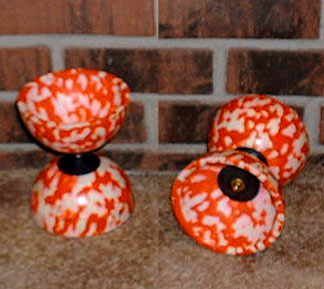Diabolo Tricks
What
is it?
(click
image for answer)
Random Image - (Refresh for another)
See Video explaining many Diabolos
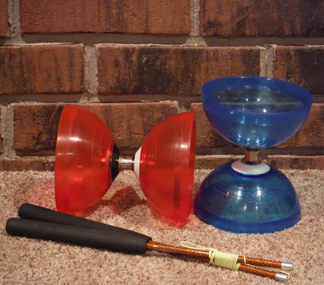 |
.jpg) |
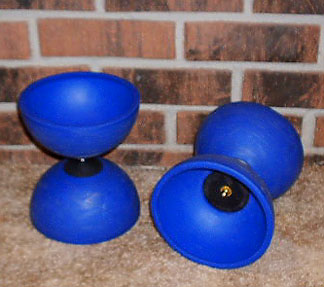 |
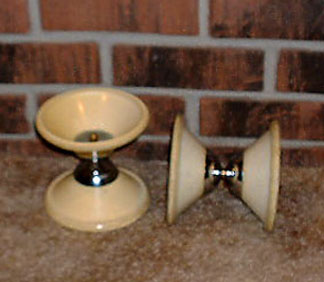 |
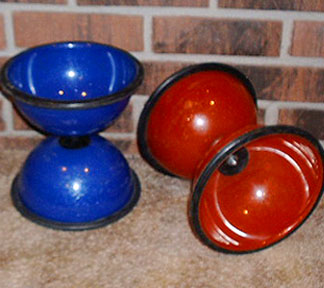 |
 |
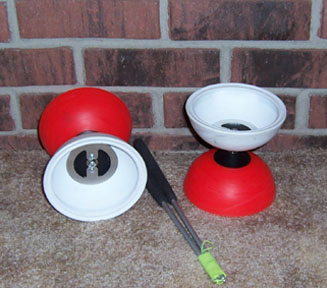 |
|||
| Babache Finesse G2 G3 | Sundia Fly | |||
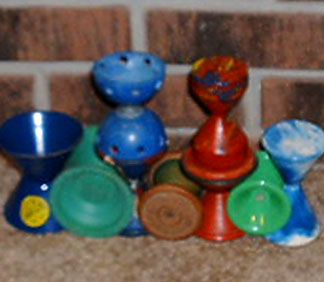 |
||||
The diabolo is said to have originated in China.
The above pictured diabolos are the European versions.
The 'cups' or sides of the European diabolos are usually spherically shaped
or conical
where the Chinese Yo-yos have flat sides like wheels.
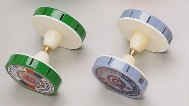
^^^^^^^^^^^^^^^^^^^^^^^^^^^^^^
Le Muse Du Diabolo This web site is full of diabolo info.
Diabolo History
It is fairly difficult to know with precision when the diabolo was invented. Historians however agree that in China, where it was discovered, the game of Diabolo has been practised for more than 4000 years. In China today, like the first ones, diabolos are still made in bamboo, with openings on the side making it whistle while spinning. French and English missionnaries brought these strange objects back to Europe, named by an unknown erudite "Diaballo" (later diabolo). In 1906, a French inventor Gustave Pillipart presented a diabolo made of two metal cup, with the edges protected by rubber. The modern diabolo was invented!
History information - courtesy of Goudurix
^^^^^^^^^^^^^^^^^^^^^^^^^^^^^
DIABOLO, a game played with a sort of top in the shape
of two cones joined at theirapices, which is spun,thrown,andcaught by means
of a cord strung to two sticks. The idea of the game appears originally to
have come from China, where a top (Kouengen), made of two hollow pierced cylinders
of metal or wood, joined by a rodand often of immense size,was made by rotation
to hum with a loud noise, and was used by pedlars to attract customers. From
China it was introduced by missionaries to Europe; and a form of the game,
known as the devil on two sticks, appears to have been known in England towards
the end of the 18th century, and Lord Macartriey is credited with improvements
in it. But its principal vogue was in France in 1812, where the top was called
le diable. Amusing old prints exist (see Frys Magazine, March and December
1907), depicting examples of the popular craze in France at the time. The
diable of those days resembled a globular wooden. dumb-bell with a short waist,
and the sonorous hum when spinningthe bruit du diablewas a pronounced feature.
At intervals during the century occasional attempts to revive the game of
spinning a top of this sort on a string were made, but it was not till 1906
that the sensation of 1812 began to be repeated. A French engineer, Gustave
Phillipart, discovering some old implements of the game, had experimented
for some time with new forms of top with a view to bringing it again into
popularity; and having devised the double-cone shape, and added a miniature
bicycle tire of rubber round the rims of the two ends of the double-cone,
with other improvements, he named it diabolo. The use of celluloid in preference
to metal or wood as its material appears to have been due to a suggestion
of Mr C. B. Fry, who was consulted by the inventor on the subject. The game
of spinning, throwing and catching the diabolo was rapidly elaborated in various
directions, both as an exercise of skill in doing tricks, and in diabolo tennis
and other ways as an athletic pastime. From Paris, Ostend and the chief French
seaside resorts, where it became popular in 1906, its vogue spread in 1907
so that in France and England it became the fashionable rage among both children
and adults.
The mechanics of the diabolo were worked out by Professor C. V. Boys in theProc.
Phys. Soc. (London), Nov. 1907.
"DIABOLO." LoveToKnow 1911 Online Encyclopedia. © 2003, 2004
LoveToKnow.
Also check out Wikipedia description of 'diabolo.'
^^^^^^^^^^^^^^^^^^^^^^^^^^^^^^
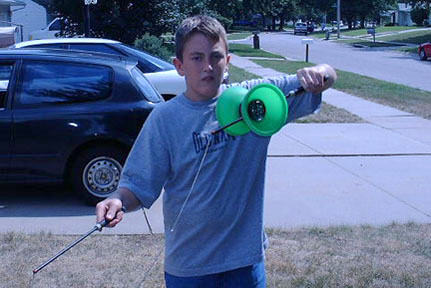 |
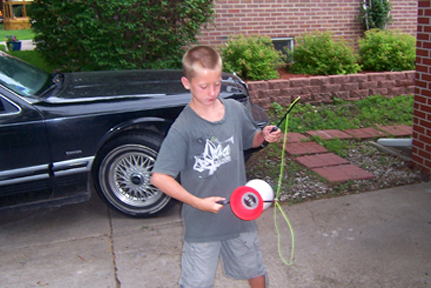 |
|---|---|
Avery demonstrates a Grind using a Mister Babache Finesse Diabolo. |
Traejen demonstrates a Grind using a Mister Babache Finesse Diabolo. |
HOME - ONE TRICK LISTING - TWO TRICK LISTING - FLASH Movie Controls
